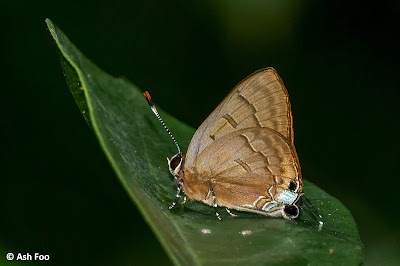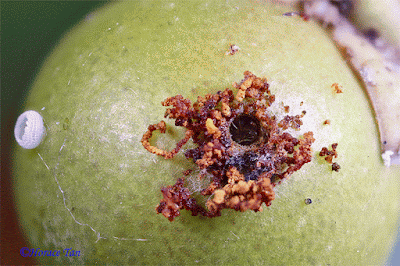The Copper Flash (Rapala pheretima sequeira)
A male Copper Flash feeding on the flower of the Mile-A-Minute at an urban park
We move past into the second half of the year and in a flash, more than half of 2024 has flown past us. Our world chugs along, but quietly and sinisterly, temperatures have risen all around the globe. Month by month, record highs are being documented in many countries, as this article in Reuters postulates that 2024 may be the world's hottest year on record. The article goes on to say, ""El Nino is a naturally occurring phenomenon that will always come and go. We can't stop El Nino, but we can stop burning oil, gas, and coal". Is the world doing enough? Or we are waiting for others to take action, like the proverbial frog in a pot of boiling water?
Also, due to climate change and rising temperatures, the spectre of global sea level rise is also an existential threat to low-lying islands like Singapore. Slowly but surely, scientists have tracked and documented the rising sea levels across the world. Sea levels in Singapore could increase by 1.37m by 2150, if temperatures rise by more than 4 deg C by the end of the century because of excessive greenhouse gas emissions. Singapore has already embarked on an ambitious plan to protect itself from the rising sea levels.
This month, we feature a species from the genus Rapala, of which there are nine extant species in Singapore. Our Butterfly of the Month for July 2024 is the Copper Flash (Rapala pheretima sequeira) a small butterfly with a wingspan of about 31-35mm. Listed as "Least Concern" in the latest Singapore Red Data Book 3rd Edition, the Copper Flash is observed regularly in urban parks and gardens, as well as the forested areas within the nature reserves.
It is a fast-flyer like all the other members of the genus and makes rapid sorties amongst low bushes and shrubbery. It is often spotted at flowering bushes where it stops to feed on nectar. When disturbed it darts off rapidly to the treetops where it perches with its wings folded upright. The Copper Flash belongs to the varuna group of the Rapala genus in which the females are a steely blue.
A female Copper Flash opens its wings to sunbathe, showing its dull steely blue upperside
The male Copper Flash is a dusky reddish-brown on the upperside, with diffused borders. The upperside of the female is a dull steely blue with broad diffused darker blue borders on both wings. The brown underside has the usual Rapala bands and features dark cell-end bars on the underside of both wings. There is an extra spot in the middle of the forewing cell, which may be reduced or even absent in the female. There is a scent brand within space 7 on the hindwing and appears as a prominently raised circular disc on the underside of the males of the Copper Flash.
A closeup of the tornal lobe on the hindwing of the Copper Flash
The hindwing has the usual black tornal spots with metallic blue scaling. However, it is the only species in the genus where the large black sub-tornal spot does not have an orange crown. There is a white-tipped filamentous tail at vein 2 of the hindwing. The eyes are jet black and the antennae are orange-tipped at the club, with white bands below the club.
The caterpillars of the Copper Flash are thus successfully bred on four local host plants - Mangifera indica, Hibiscus tiliaceus, Syzygium zeylanicum and Mallotus paniculatus. It is highly likely that the caterpillars of the Copper Flash feeds on more host plants, which partly explains its wide distribution across Singapore and generally quite commonly spotted throughout the year.
Text by Khew SK : Photos by Ash Foo, David Ho, Khew SK, Michael Khor, Loh MY, Neo TP, Simon Sng and Bene Tay



























































